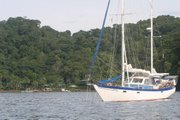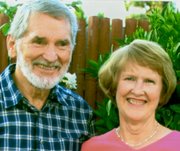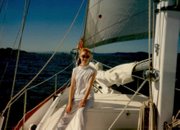Our latest cruising season began, as is customary, with a road trip from Lake Stevens down to Eugene, to spend a few days with my family. We stayed with Vickie and Jon, and Debra had all the brothers and sisters and spouses for dinner at her house. Jon accompanied us to the airport in mid-afternoon on Monday and took our truck back to baby sit it for the winter. And soon we were off for Los Angeles; San Jose, Costa Rica; and Guayaquil, Ecuador, where we arrived in mid-afternoon on Tuesday, feeling remarkably well despite having been in combinations of airports and airplanes for about 24 hours.
Customs in Guayaquil was a matter of turning in our declarations, picking up our five bags, piling them on a cart along with the four we were carrying, and waving to the guards as they waved us out the door. Stepping outside the terminal, we paused a few moments to take deep breaths of the hot, humid air enveloping us—something of a shock after the past few weeks in the cool Pacific Northwest.
In the luck of the draw, we happened upon the perfect van and driver to take us from Guayaquil to the Puerto Lucía Yacht Club, about 100 miles to the west. The van was a new Toyota with air-conditioning that worked, and the driver spoke English. He had lived in New York for many years, where his Puerto Rican wife and daughter continue to live while he resides temporarily in Guayaquil, taking care of his ill mother. We had a speedy, comfortable, and enjoyable ride out to the coast.
Once again, we spent the first four nights in the PLYC hotel while the workers in the yard completed their refinishing of the teak on Carricklee and sanded and painted the bottom and Bob returned all the boat’s systems to working status. We had virtually no mildew below decks to clean this year, having left two open buckets filled with a strong bleach and water solution sitting in the sinks. After five months, both buckets still had an inch or so of liquid remaining.
On our fifth day back, the Travelift cradled Carricklee in its slings, transported her to the marina dock, and lowered her into the water. Then we motored across to the sea wall, where yard workers tied our stern line to a mooring and others waited on the rocky wall to take the bow lines to cleats on the wall. And here we sat for the next four weeks, the lone occupants on the boats on the wall.
But we had plenty of company among the many boats still hauled out and joined in the ongoing active social life. While we’d been away for the summer, the yacht club had converted one large room in the complex to a cruisers’ lounge. Besides several large round tables, where we joined the group for weekly potlucks, the lounge has four computer stations with Internet connections, so we no longer had to take the hike to the shopping center for Internet access.
For our daily hikes, we instead walked around the yacht club complex for about 45 minutes early in the mornings and enjoyed splendid birding each day. The chattering green parrots were waking up and getting under way for their daily flights to wherever it is they go to feed. Long-tailed mockingbirds provided the music for the walks, with the occasional tiny clicking hummingbirds the timpanists, while the vermillion flycatchers added quiet color.
The one significant equipment failure on the boat for which we had no spare parts was the dead battery we discovered in the satellite phone a few days before our departure for Panamá. As with too many pieces of equipment on our boat, we learned when we contacted Telenor, the distributor of the phone, that our model has long been out of production. However, on our last day in PLYC, the Telenor rep. sent an e-mail to say she had rounded up two re-conditioned batteries and would send them to us, free of charge, with of course no guarantees either would still power the equipment. Of course we would not receive them until we reached Panamá. So we’d have neither e-mail nor phone access for the passage.
Wednesday, November 29, 2006
Subscribe to:
Post Comments (Atom)






No comments:
Post a Comment